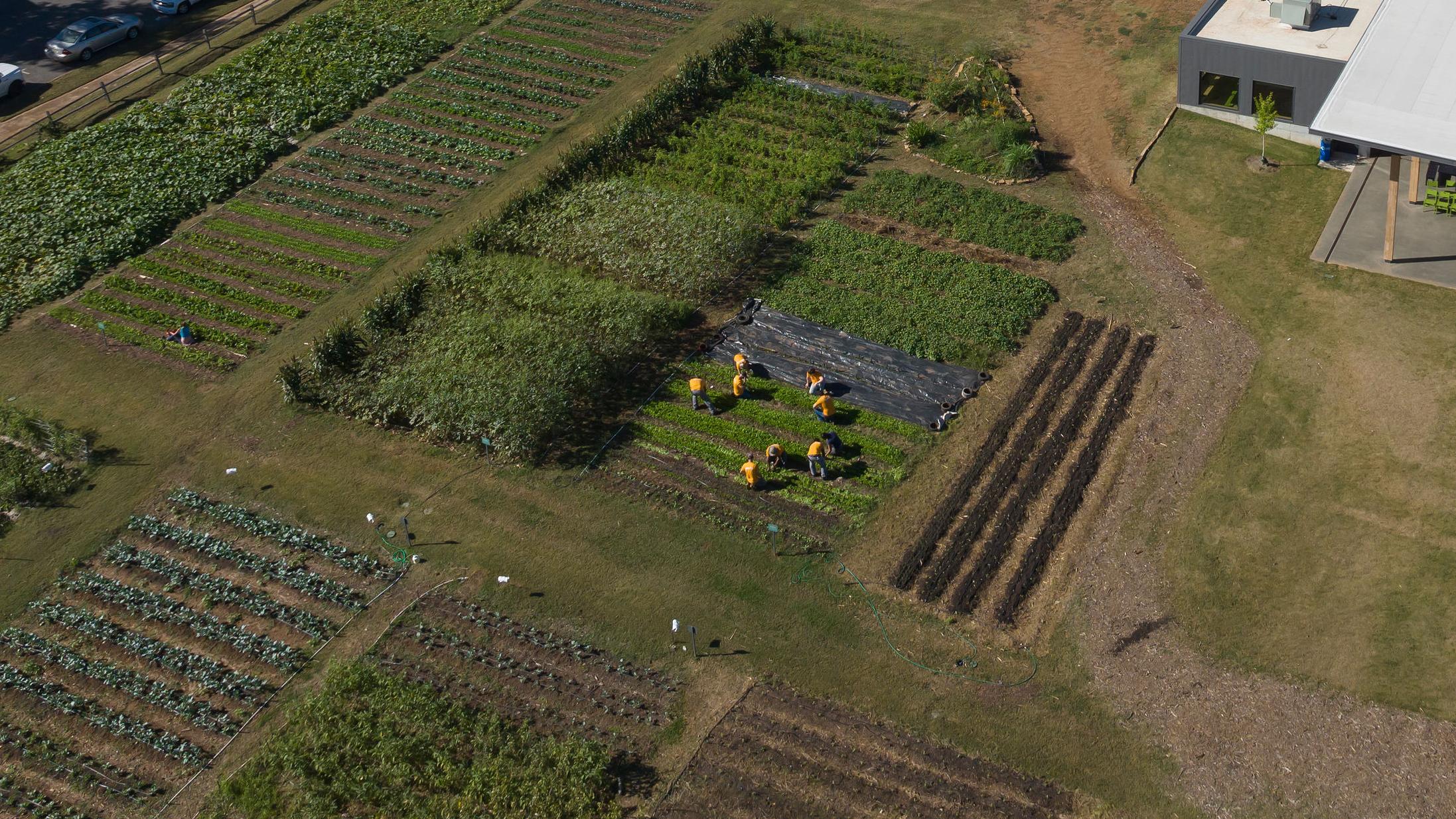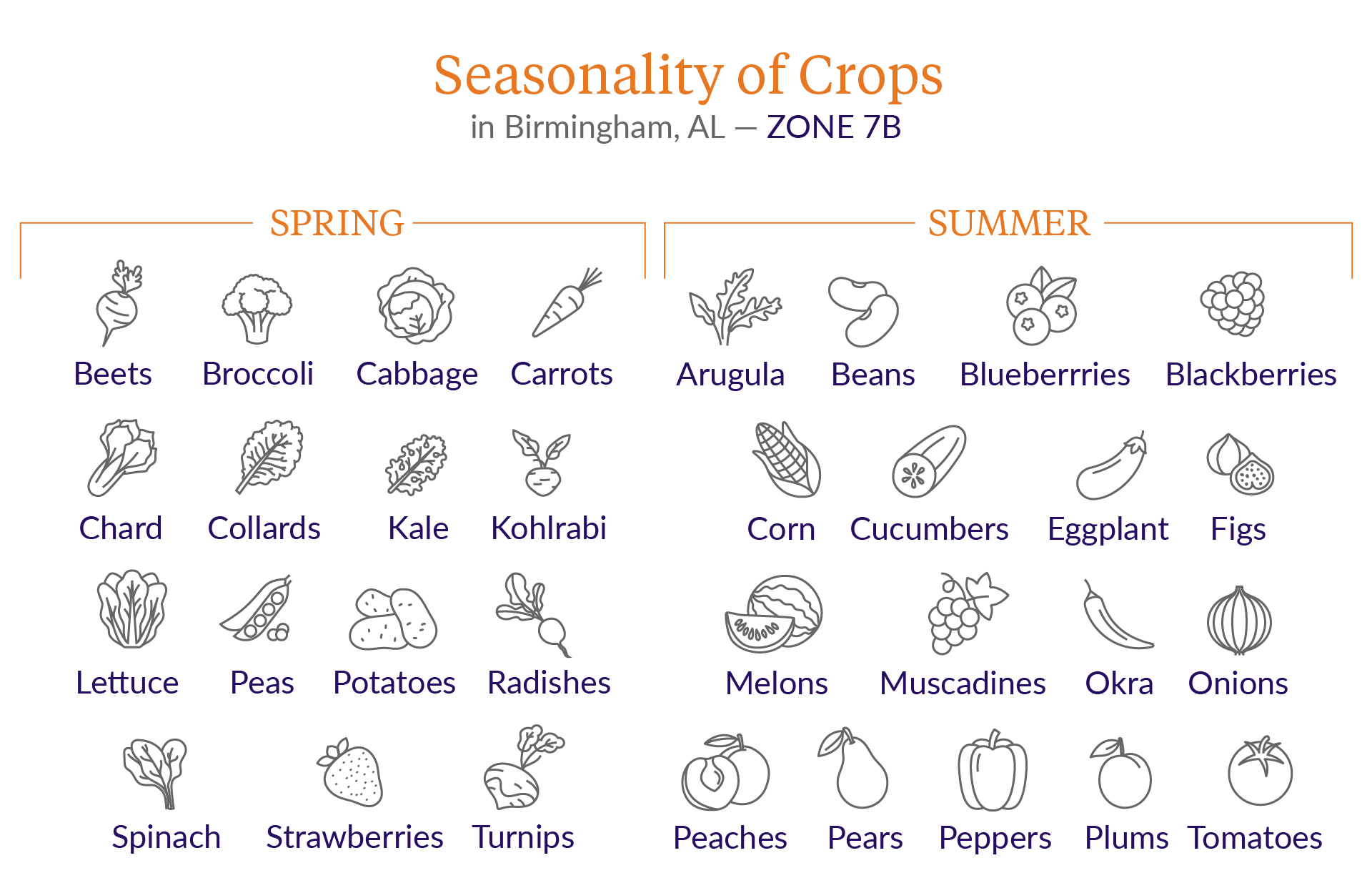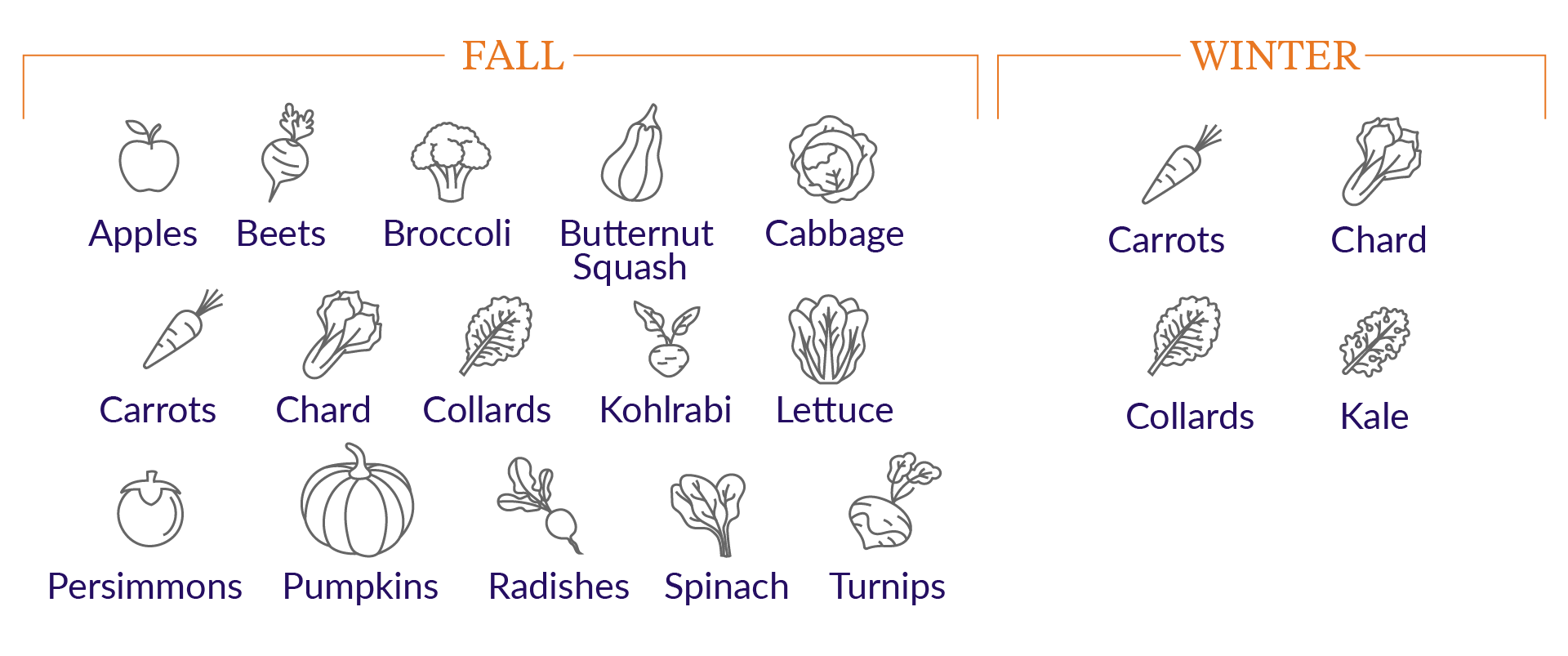
default

Sowing southern roots
At Spire, we believe communities should all have access to nutritious meals, and we're honored to support organizations like Jones Valley Teaching Farm that include urban gardening in their food education. So as we move into a new season, it's important to remember that crops have favorite seasons, too. Check out this handy guide from Jones Valley on the best time of year to grow crops in Alabama Zone 7B.


Source: Jones Valley Teaching Farm
- Growing seasons: Fall, Winter, Spring
- Edible parts: Roots, leaves
Nutrition information:
- Contains fiber (which helps with digestion, lowers cholesterol and blood sugar and promotes a healthy weight)
- Contains large amounts of beta-carotene, which our body turns into Vitamin A (which helps keep our eyes, skin and immune system healthy)
Recipe: Carrot Pancakes
Ingredients:
- 1 ½ cups whole wheat flour
- 1 ½ tsp baking powder
- 1 tsp baking soda
- 1 tsp ground cinnamon
- ½ tsp ground nutmeg
- ½ tsp ground ginger
- 1 ½ tsp vanilla extract
- 1-2 eggs
- 3 Tbsp packed brown sugar
- 1 ½ cups buttermilk
- 1 tsp salt
- 3 cups finely grated carrots
- Butter, for griddle
Instructions:
Whisk together the flour, baking powder, baking soda, salt, cinnamon, nutmeg and ginger.
In a smaller bowl, whisk together the egg, brown sugar, buttermilk and vanilla. Stir in the carrots.
Dump the wet mixture into the dry mixture all at once. Stir just until incorporated. While mixing, have your griddle preheating.
In a skillet/griddle, over medium heat, melt a big pat of butter. Pour ¼ cup batter into the hot pan, using the measuring cup to pat the batter down and spread out a bit. Cook, flipping once, until the pancakes are golden on both sides.
Fun Fact:
Before the 17th century (about 400 years ago), the only edible types of carrots were black, white, red, and purple. Orange carrots were created by selective breeding in the Netherlands as a tribute to the Dutch royal family, House of Orange.
- Growing seasons: Fall, winter, spring
- Edible parts: Flower, stem
Nutrition information:
- Contains vitamin C (promotes a healthy immune system)
- Contains calcium and vitamin K (helps build strong bones)
- Contains fiber (helps with digestion, lowers cholesterol and blood sugar and promotes a healthy weight). Just one cup of cooked broccoli contains 21 percent of your daily suggested intake of fiber
Recipe – Teriyaki carrots & broccoli
Ingredients:
- 4-5 Medium carrots, diced
- 1 Broccoli head, diced
- 3 Cloves garlic, minced
- 4 Tbsp soy sauce
- 3 tsp brown sugar
- 1 tsp ginger
- 1 Tbsp corn starch
Instructions:
- In a small saucepan over medium-low heat, combine soy sauce, brown sugar, garlic, ginger and corn starch. Stir occasionally, for about 5 minutes, until the sauce has thickened. Set aside.
- Add carrots and broccoli to the saucepan. Coat with sauce and cook until tender, for about 5-6 minutes.
Fun fact:
Each little bud on a broccoli floret is a flower ready to bloom. When left unharvested, broccoli will burst into a bunch of white or yellow flowers.
- Growing seasons: Fall, spring
- Edible part: Leaves
Nutrition information:
- Contains vitamin C (promotes a healthy immune system)
- Contains calcium and vitamin K (helps build strong bones)
- Contains fiber (helps with digestion, lowers cholesterol and blood sugar and promotes a healthy weight)
Recipe: One pot pasta with spinach & tomatoes
Ingredients:
- 1 Tablespoon olive oil
- 1 Cup chopped onion
- 6 Garlic cloves, finely chopped
- 1 (14.5-ounce) Can petite diced tomatoes, undrained
- 1 1/2 Cups unsalted chicken stock
- 1/2 teaspoon dried oregano
- 8 Ounces whole-grain spaghetti
- 1/2 teaspoon salt
- 10 Ounces fresh spinach
- 1 Ounce Parmesan cheese, grated
Instructions:
- Heat a Dutch oven or large saucepan over medium-high heat. Add oil; swirl to coat.
- Add onion and garlic to pan; sauté 3 minutes or until onion starts to brown.
- Add tomatoes, stock, oregano, and pasta, in that order. Bring to a boil.
- Cover, reduce heat to medium-low, and cook 7 minutes or until pasta is almost done.
- Uncover; stir in salt. Add spinach in batches, stirring until spinach wilts. Remove from heat; let stand 5 minutes. Sprinkle with cheese and serve. Enjoy!
*recipe from cookinglight.com
Fun fact:
Unlike most veggies, cooking spinach intensifies the health benefits. Half a cup of cooked spinach will grant you with triple the nutrition as one cup of raw spinach.
- Growing seasons: Spring, summer
- Edible part: Fruit
Nutrition information:
- Contains vitamin C (promotes a healthy immune system)
- Contains potassium (helps to regulate normal blood pressure)
Recipe: Spring greens and strawberry salad
Ingredients:
- 2 Cups ripe strawberries, sliced
- 8 Cups mixed salad greens
- 1/2 Red onion, sliced thinly
- 1/3 Cup sliced almonds or pecan pieces (optional)
- 1/3 Cup feta cheese crumbles (optional)
- Fresh ground black pepper
- 2 tsp aged balsamic vinegar
- 2 tsp Dijon mustard
- 2 tsp maple syrup (or honey)
- 1/4 tsp kosher salt
- 6 Tbsp olive oil
Instructions:
- Wash and slice the strawberries. Wash and dry the salad greens.
- Thinly slice the red onion
- Make the balsamic vinaigrette**: In a small bowl, whisk together the balsamic vinegar, Dijon mustard, maple syrup, and kosher salt. Then gradually whisk in the olive oil 1 tablespoon at a time until fully emulsified and creamy.
- To serve, spread the greens on a plate and top with strawberries, red onion, vinaigrette, and several shakes of black pepper. Add feta cheese crumbles and sliced almonds or pecans if you choose to do so.
**You can also purchase a pre-made balsamic vinaigrette from the store
Fun fact:
The average strawberry contains around 200 seeds on the surface of its skin!
- Growing seasons: Spring, fall
- Edible parts: Roots, leaves
Nutrition information:
- High in fiber (relieves intestinal problems, aids in digestion)
- High in vitamin C (promotes healthy immune systems)
Recipe: Mashed Turnips
- 2 lbs. turnip roots, washed & quartered
- 1 lb. potatoes, washed & quartered
- 3 tbsp. butter
- 4 green onions, finely chopped
- 1 cup milk
- Salt and pepper, to taste
Note:
- Substitute low-fat milk or greek yogurt for whole milk
- Leave the skin on the potatoes and turnips for extra fiber
- Save the turnip greens to make another dish
Instructions:
- Add turnips and potatoes to a large pot of salted water. Bring water to a boil over high heat, then reduce heat to medium and allow to simmer until tender (about 20 minutes). Drain and set aside.
- Meanwhile, in a medium skillet, saute butter with green onions over medium heat until softened (about 5 minutes).
- Add drained potatoes and turnips back to the pot. Add butter and onion mixture along with milk. Mash to desired consistency. Add salt, pepper, more milk or butter, to taste. Serve and enjoy!
Fun fact:
Before pumpkins were used to make jack-o-lanterns, people carved faces into turnips and used them as lanterns to ward off evil spirits during some of the first Halloween celebrations.
- Growing seasons: Fall, winter, spring
- Edible parts: Leaves, flowers
Nutrition information:
- High in fiber (relieves intestinal problems, aids in digestion, and helps regulate blood sugar)
- Contains folate (a B-vitamin key for brain development)
- Contains more calcium than milk and more Vitamin C than an orange
Recipe: Kale chips
Ingredients:
- 1 Bunch of kale
- 1 Tbsp. olive oil
- Seasonings of your choice
Notes:
- For spicy kale chips, add a bit of cayenne pepper
- For sweeter kale chips, add some cinnamon sugar
Instructions:
- Preheat oven to 300 degrees F.
- Remove stems from kale and cut or rip leaves into 1” pieces
- Toss kale with olive oil and seasonings.
- Lay evenly across baking sheet. Bake until crisp, about 20-30 minutes.
- Remove from oven and enjoy!
Fun Fact:
Kale is a part of the family of brassicas, which also includes broccoli, cabbage, and collard greens!
.blog-grid-preview .field--name-field-recipe-media img, .popular-posts-grid .field--name-field-recipe-media img, .popular-recipe-grid .field--name-field-recipe-media img, .chef-grid .field--name-field-recipe-media img, .recipe-landing .field--name-field-recipe-media img, .view-blog-taxonomy-archive .field--name-field-recipe-media img, .view-recommended-blog-posts .field--name-field-recipe-media img, .view-latest-blogs .field--name-field-recipe-media img, .block-views-blockrecommended-blog-posts-recommended-blog-posts .field--name-field-recipe-media img {
width: 100%;
}
- Growing season: Fall, winter, spring
- Edible part: Leaves
Nutrition information:
- Packed with anthocyanins, which boosts immunity and helps reduce risk of heart disease and diabetes. (They also give red cabbage its purple color!)
- High in fiber (helps with digestion, lowers cholesterol & blood sugar, and promote a healthy weight)
Recipe: Chow-Chow
Ingredients:
- 2 Cups green bell pepper
- Diced 2 cups red bell pepper
- Diced 1 ½ cups green tomatoes
- Diced 1 ½ cups green cabbage
- Diced ½ cup apple cider vinegar
- 2 Cups onion
- Diced 1 tbsp. kosher salt
- ¼ Cup water
- ¼ tsp. celery seeds
- ¼ tsp. turmeric
- ¼ tsp. ground ginger
- ¾ Cup granulated sugar
- ¾ tsp. ground mustard
- 1 ½ tsp. mustard seeds
- ½ tsp. red pepper
Instructions:
- In a large non-reactive skillet, bring water, salt, sugar and spices to a simmer.
- Add vinegar and bring to a boil before adding vegetables.
- Stir to coat all the vegetables, reduce heat to medium and continue to cook and stir for approximately 5-10 minutes until the vegetables become tender.
- Transfer to glass jars and refrigerate (will keep for 2-3 weeks in a refrigerator).
Fun fact:
Cabbage is a staple in the Russian diet, because it thrives in cool weather. Russians eat more than seven times as much cabbage as the average North American!